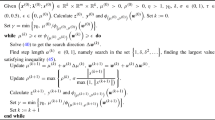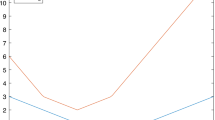Abstract
A primal-dual path-following algorithm that applies directly to a linear program of the form, min{c t x∣Ax = b, Hx ⩽u, x ⩾ 0,x ∈ ℝn}, is presented. This algorithm explicitly handles upper bounds, generalized upper bounds, variable upper bounds, and block diagonal structure. We also show how the structure of time-staged problems and network flow problems can be exploited, especially on a parallel computer. Finally, using our algorithm, we obtain a complexity bound of O(\(\sqrt n \) ds 2 log(nk)) fortransportation problems withs origins,d destinations (s <d), andn arcs, wherek is the maximum absolute value of the input data.
Similar content being viewed by others
References
A.V. Aho, J.E. Hopcroft and J.D. Ullman,The Design and Analysis of Computer Algorithms (Addison-Wesley, Reading, MA, 1974).
E.R. Barnes, “A variation on Karmarkar's algorithms for linear programming,”Mathematical Programming 36 (1986) 174–182.
J.R. Birge and L. Qi, “Computing block-angular Karmarkar projections with applications to stochastic programming,”Management Science 34 (1988) 1472–1479.
I.C. Choi, C.L. Monma and D.F. Shanno, “Further development on primal-dual interior point method,”ORSA Journal on Computing 2(4) (1990) 304–311.
I.I. Dikin, “Iterative solution of problems of linear and quadratic programming,”Doklady Akademii Nauk USSR 174 (1967). [Translated in:Soviet Mathematics Doklady 8 (1967) 674–675.]
C.M. Fiduccia and R.M. Mattheyses, “A linear-time heuristic for improving network partitions,”Proceedings 19th Design Automation Conference (1982) 175–181.
R.M. Freund, “Polynomial-time algorithms for linear programming based only on primal scaling and projected gradients of a potential function,”Mathematical Programming 51 (1991) 203–222.
P.E. Gill, W. Murray and M.A. Saunders, “A single-phase dual barrier algorithm for linear programming,” Technical Report SOL 88-00, Systems Optimization Laboratory, Department of Operations Research, Stanford University (Stanford, CA, 1988).
P.E. Gill, W. Murray, M.A. Saunders, J.A. Tomlin and M.H. Wright, “On projected Newton barrier methods for linear programming and an equivalence to Karmarkar's projective method,”Mathematical Programming 36 (1986) 183–209.
D. Goldfarb and M.J. Todd, “Linear Programming” in: G.L. Nemhauser, A.H.G. Rinnooy Kan, M.J. Todd, eds.,Handbook in Operations Research and Management Science, Vol. 1, Optimization (North-Holland, Amsterdam, 1989).
G.H. Golub and C.F. Van Loan,Matrix Computations (The Johns Hopkins University Press, Baltimore, MD, 1983).
C. Gonzaga, “An algorithm for solving linear programming in O(n 3 L) operations,” in: N. Megiddo, ed.,Advances in Mathematical Programming—Interior Point and Related Methods (Springer, Berlin, 1989). Chapter 1.
S. Kapoor and P.M. Vaidya, “Speeding up Karmarker's algorithm for multicommodity flows,” manuscript, Department of Computer Sciences, University of Illinois at Urbana-Champaign (Urbana, IL, 1988).
N.K. Karmarkar, “A new polynomial-time algorithm for linear programming,”Combinatorica 4 (1984) 373–395.
N.K. Karmarkar and K.G. Ramakrishnan, “Implementation and computational results of the Karmarkar algorithm for linear programming, using an iterative method for computing projections,” Technical Memorandum No. 11211-891011-10TM, AT&T Bell Laboratories (Murray Hill, NJ, 1989).
B.W. Kernighan and S. Lin, “An efficient heuristic procedure for partitioning graphs,”Bell System Technical Journal 49 (1970) 291–307.
I.J. Lustig, R.E. Marsten and D.F. Shanno, “Computational experience with a primal-dual interior point method for linear programming,”Linear Algebra and its Applications 152 (1991) 191–222.
K. Masuzawa, S. Mizuno, and M. Mori, “A polynomial time interior point algorithm for minimum cost flow problems,”Journal of the Operations Research Society of Japan 33 (1990) 157–167.
S. Mehrotra, “On the implementation of a primal—dual interior point method,” Technical Report 90-03, Department of Industrial Engineering and Management Sciences, Northwestern University (Evanston, IL, 1990).
S. Mizuno and K. Masuzawa, “Polynomial time interior point algorithms for transportation problems,”Journal of the Operations Research Society of Japan 32 (1989) 371–382.
R.C. Monteiro and I. Adler, “Interior path-following primal-dual algorithms. Part 1: Linear programming,”Mathematical Programming 44 (1988) 27–41.
D. Moore, “A round-robin parallel partitioning algorithm,” TR 88-916, Department of Computer Science, Cornell University (Ithaca, NY, 1988).
J. Renegar, “A polynomial-time algorithm, based on Newton's method, for linear programming,”Mathematical Programming 40 (1988) 59–93.
R.E. Tarjan, “Depth first search and linear graph algorithms,”SIAM Journal of Computing 1(2) (1972) 146–160.
M.J. Todd, “Exploiting special structure in Karmarkar's linear programming algorithm,”Mathematical Programming 41 (1988) 97–113.
Y. Ye, “A O(n 3 L) potential reduction algorithm for linear programming,”Mathematical Programming 50 (1991) 239–258.
Author information
Authors and Affiliations
Additional information
This research was supported in part by NSF Grants DMS-85-12277 and CDR-84-21402 and by ONR Contract N00014-87-K-0214.
Rights and permissions
About this article
Cite this article
Choi, I.C., Goldfarb, D. Exploiting special structure in a primal—dual path-following algorithm. Mathematical Programming 58, 33–52 (1993). https://doi.org/10.1007/BF01581258
Received:
Revised:
Issue Date:
DOI: https://doi.org/10.1007/BF01581258




